 TOURS AND ATTRACTIONS TOURS AND ATTRACTIONS |
 THINGS YOU CAN SEE THINGS YOU CAN SEE |
 ANTIGUA ANTIGUA |
link

Cathedral of San José
Built between 1543 and 1680 only the facade and wall structure remain. Excavations in 1935 revealed crypts beneath the Cathedral. One remains open and contains an altar, a crucifix and statues of saints. Legend claims the tomb of Don Pedro de Alvarado, conquistador is buried in the cathedral. Open daily from 9-12 a.m. and 3-7 p.m.
City Hall
Built in 1743, it remains occupied and shows the rich colonial architecture.
Colonial Museum
Occupies the Old Royal and Pontifical University of San Carlos de Borromeo. A library with colonial art treasures, including a painting of Don Pedro de Alvarado are fascinating to see. Open 9-12 a.m. and 2-6 p.m. daily.
Compañía De Jesús Church, Convent and School
The building is crowded with colorful markets on Monday, Thursday and Saturday.
Convent of Santa Clara
Many of its arches and walls remain intact and surround a fountained patio.
La Merced Church
Survived the earthquake of 1773. The facade is decorated with lacy white stucco and the church contains many statues. The courtyard contains an elaborate Spanish colonial fountain.
The Palace of the Captains General
Made up of 26 two-story arches which extend over one hundred meters. The provincial government of the department of Sacatepequez offices are located there. The building has been renovated but still contains some ruins.
Plaza de Armas
The central plaza has a fountain with fine tile works. And remains the center of activity today were fiestas, celebrations and public events are held.
San Francisco
Home to hundreds of monks, the revered Brother Pedro de Bethancourt, who died in 1667, is buried here. The chapel contains fine paintings and other artifacts.
Santiago Museum
Colonial arms, artillery pieces, costumes, and other works of art. Open 9-12 a.m. and 2-6 p.m. daily.
Antique Book Museum
Guatemalas first printing shop. Displays valuable first editions and ancient documents. Some fine 17th century etchings in stone. Open daily 9-12a.m. and 2-6 p.m.
San Antonio Aguas Calientes
Small town known for its weavings. Some of the best in Guatemala are found here in terms of tightness, design, and color combination. Admire the weavings at roadside stands throughout the town.
 GUATEMALA CITY GUATEMALA CITY |
link
Botanical Gardens
Located on Avenida Reforma these gardens have thousands of different species of flora. Most are labeled with species name in Latin and Spanish. A site not to miss.
Relief Map of the Republic
Built in 1905 by Francisco Vela, the map covers 990 square meters and can be viewed from platforms located on each side.
The Cathedral
Built between 1782 and 1868, it has many art treasures originally in the cathedral in Antigua on display.
The National Palace
One of the most prominent historical buildings in the city. Murals by Alfredo Suarez depict the conquest of Guatemala and many of the ornate state chambers can be visited with advanced permission.
The Popol Vuh Museum
Exhibits vestiges of the Maya culture such as stone sculptures from the Pacific slopes and the highlands, and ceramics from different regions of the south coast. The colonial section displays silverware, paintings, side altars and large silver sculptures. The folklore section has over 400 masks, costumes and other items. It's the only museum in the world with Maya Sarcophagus. Open Monday through Saturday 9-12 a.m. and 2-5:30 p.m.
The Civic Center
Home to City Hall, the Bank of Guatemala, the Supreme Court of Justice and the Miguel Angel Cultural Center.
Ixchel Museum
Outstanding collection of native costumes. Displays ceramics, jewelry and books. Open 9 a.m - 5:30 p.m.
Kaminal Juyú
Important site of the pre-Hispanic Period. Outstanding ceramic sculptures and architecture.
National Museum of History and Fine Arts
Contains paintings and contemporary sculptures, portraits of the 19th century, flags, photographs and maps. Open Tuesday thru Sunday 9 a.m - 4:30 p.m.
National Museum of Archaeology and Ethnology
Includes six permanent exhibits containing over a thousand volumes of data on archaeology ethnology, languages and physical anthropology of the Indians of the Americas. Open Tuesday thru Friday 9-4p. Saturday and Sunday 10-12 a.m. and 2-4 p.m.
National Museum of Natural History
Contains sections on zoology, paleontology, botany, geology and mineralogy. Open Monday thru Friday 9 a.m. - 4:30 p.m.
La Aurora National Zoo
Opened in 1925, it's one of the oldest zoos in operation in Latin America. You can see over 100 species of animals, some of which include spider monkeys, macaws, coatis, curasaws, parrots and parakeets. An admission and parking fee are charged. Open Tuesday thru Sunday 9 a.m. - 5 p.m..
Metropolitan Museum of Science and Technology
Over 54 exhibits of science and technology. Open Monday thru Friday 9 a.m. - 4:30 p.m.
 HUEHUETENANGO HUEHUETENANGO |
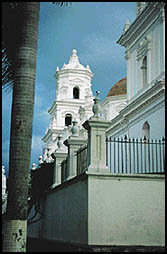
Chiantla
Church famous for silver image of the Virgin Mary.
Zaculeu
The ruins are from the post-classic period of the Maya culture. Series of buildings with strategic defense layout.
Todos Santos Cuchumatanes
Isolated town that is amid mountains rising up two miles. Local fiesta from October 31 to November 5 when horse races and other forms of celebration can be seen.
 LAKE ATITLAN AND THE HIGHLANDS LAKE ATITLAN AND THE HIGHLANDS |
link
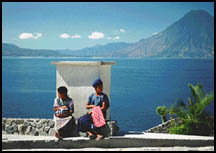
Santa Catarina Palopó
A small picturesque hillside town 2.5 miles from Panajachel, can be reached by car.
San Lucas Tolimán
Reached by boat from Panajachel, taking about 15 minutes. Beautiful village with indigenous Indians.
Santiago Atitlán
The largest of the lake towns, you'll find beautiful textiles of the area for sale in the market. Boats leave from Panajachel daily at 9:00 a.m. and return at 1:00 p.m.
Sololá
One of the major market areas of the western highlands, the plaza and streets are filled with people from all over the region selling their crafts. Founded in 1547 it is the capital of the department of Sololá.
San Andrés Semetabaj
Distinctive because of an ancient colonial church in the town.
 CHICHICASTENANGO CHICHICASTENANGO |
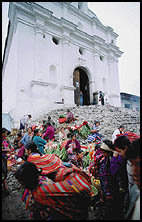
Church of Santo Tomás
Whitewashed colonial structure built around 1540. On the steps people pray and burn copal incense. Once inside they offer candles and flowers to the souls of the departed.
The Museum
Contains a beautiful jade collection, ceramic figures, household objects and incense burners. Open each day except Tuesday from 8 -12 a.m. and 2-5 p.m.
Pascual Abaj
Stone idol located on the hilltop about a half mile from town. Folkloric legend claims a very poor hunchback lived on the hilltop and promised good fortune to those that gave him aid.
 QUETZALTENANGO QUETZALTENANGO |
Natural History Museum
Displays include pottery from the Pacific lowland area, pre-Columbian ceramic and jade, native costumes and stuffed animals and birds. Open Tuesday thru Saturday 9-12 a.m. and 2-5 p.m.
Sulphur Springs
The entire region contains hot sulphur springs some of which can be located in towns such as Fuentes Georginas, Aguas, Amargas and Los Vahos.
San Francisco El Alto
The most picturesque town in the region. From the town plaza the volcanos Santa Marina de Cerro Quemado can be seen. The animal market on Friday is one of the most spectacular in the country.
Momostenango
Where most of Guatemalas heavy woolen blankets are woven on large foot looms.
 THE CARIBBEAN THE CARIBBEAN |
link
The Rio Dulce River
Beautiful and picturesque river runs through a three hundred foot gorge.
Siete Altares
A series of small pools and waterfalls where the river empties into the sea.
Lake Izabal
The largest of Guatemala's lakes, it's rich in game fish including perch and tarpon. Unique to the lake is the fresh water manatee, weighing up to a ton.
Stelaes of Quiriguá
The largest block of stone ever quarried by the ancient Mayas is found here. The giant stone, carved in 771 A.D. from sandstone, measures 35 feet long by 5 feet wide and weighs 65 tons.
Quiriguá
One of the most important sites in Guatemala. Located in the Izabal Banana Plantation it reached its peak of importance between 550 and 850 A.D. Stelaes and Zoomorphic sculptures are located at the ceremonial plaza which are of great importance as they represent culture and Maya history. |
Castillo De San Felipe
Thought of originally as a defense fortress, it was also used at times as a prison. The castle may be reached by boat from Rio Dulce bridge.
Punta De Manabique
Isolated beach reached by boat. A good place for picnics and swimming.
The Chocón Machacas Natural Reserve
Mangrove forest along the Rio Dulce River established for the protection of the manatee. Located an half an hour by boat from Livingston.
Livingston
A village with the magic of the Garifuna. Excitement abounds during their exotic Afro-Caribbean festivals and celebrations. Dates to remember are November 26, December 12, New Years day and Carnival.
San Gil Ecological Reserve
A refuge for the wilderness of Central America. Las Escobas river gives the traveler the opportunity to gaze at the untouched forest and see and swim in the crystal clear water pools and waterfalls.
 PACIFIC COAST PACIFIC COAST |
link
Abaj Takalik
Important archaeological site with two distinct sculptures of great importance to the development of civilization of Central America.
Lake Amatitlán
Tour the lake and enjoy the landscape. Visit the Indian market held under a huge cottonwood tree (Guatemala's national tree). Located off the road to the Pacific only 40 minutes from Guatemala City.
Monterrico
Enjoy the sun and beach, visit the Biotopo and take a canoe ride through the mangroves.
Tiquizate
Visit a Banana plantation on the road to Rama Blanca.
 COBAN COBAN |
Quetzal Biotopo
A magic world of tumbling waterfalls, flowing brooks, fragrant ferns and ancient trees full of hummingbirds and hundreds of different orchids and exotic flowers. Two trails to choose from makes your trip even more enjoyable.
Chixoy
Site of the largest dam of its kind in Central America. Capable of supplying all of Guatemala with electricity.
Cahabon River
Enjoy rafting down the river. Portage around the Chulac Falls and continue downstream to the lower gorge. The river flows into a rugged canyon with exciting rapids and calm pools.
Semuc Champey
Six miles south of Lanquín. Natural pools and wild rivers are a contrast of color and motion.
 THINGS YOU CAN DO THINGS YOU CAN DO |
 Caving Caving |
There are a number of caves to explore including those in Poptún, Petén and Candelaria.
 Horseback riding Horseback riding |
Many tour operators offer horse riding in the highlands and other places.
 Hang Gliding Hang Gliding |
The mountains that surround Lake Atitlan and Amatitlan are perfect for the sport. An international competition is held each year at Lake Atitlán.
 Pilgrimage to Esquipulas Pilgrimage to Esquipulas |
The city of peace with its 17th Century church is where the Black Christ is worshipped. It was in Esquipulas in 1985 that the first agreements for peace in Central America were signed by the five presidents of Central America.
 Rafting Rafting |
White water and calm water rafting are available in many different areas of the country. Including the Usumacinta, Chiquibul, Cahabon, Motagua, Naranjo and Candelaria rivers.
 Archaeological Sites Archaeological Sites |
Tikal
Massive ruins are concentrated at the center of the Tikal National Park (222 sq. miles). There are over 3000 separate constructions: temples, shrines, ceremonial platforms, residences, ball-courts, terraces, causeway, and plazas. Over 200 stone monuments: sculptured and plain stelae and altars. See the Great Plaza, the Temple of the Great Jaguar, the Temple of the Mask, and many, many more.
Tikal Museum
Contains representative collection of pottery, bone, shell, jade and stone.
Uaxactún
Believed to be the place where the Mayan culture became permanently consolidated, where the writing system was perfected and the calendar started. Accessible during the dry season only about 16 miles north of Tikal.
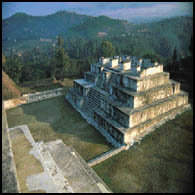
Ceibal
The Ceibal stale are some of the finest and well preserved sculptures of the late Classic Maya. Ceibal is often called thee Maya Art Gallery.
Altar de Sacrificios
A small site, west of Ceibal, close to the Usumacinta River on the Mexican border near Chiapes It was of vital importance during the 7th and 8th centuries AD, due to its strategic position on the trade routes.
Tayasal
Where the Itzaes came to settle when expelled from the Yucatan in the 13th century. Located on the shore of Peten Itza lake where the City of Flores was built in the place occupied by Tayasal.
Aguateca
Not for the average tourist. There are no imposing temples, but getting there is half the fun. Arrive by boat if the water level is high enough otherwise you must walk the shallow parts of the lake.
Río Azul
Located 48 miles northeast of Tikal on the border of Mexico. The site contains over 500 constructions including a 150 foot tall pyramid, a funeral room from the year 400 A.C. which has beautiful wall paintings, and a pot with a screw cover.
Yaxjá
One of the few sites that has an urban arrangement. Street networks have buildings facing them revealing what is thought to be the first block systems.
La Democracia
Located in the Department of Escuintla, in the Pacific lowlands. This site was home to the Preolmecs thought to be the ancient of all Maya cultures.
 Reserves Reserves |
The Maya Biosphere Reserve
Located in northern Guatemala, it is the largest protected area with more than 7000 square miles of many different types of flora and fauna. An oasis of forests and natural pastures, the biosphere has the largest fresh water wetlands in Central America. It is an important refuge for mammals such as deer, tapir, jaguars, puma and monkeys.
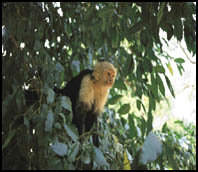
The Sierra de Las Minas Biosphere Reserve
Located in the eastern part of the country it ranges in altitude from 480 feet to over 9,000 feet above sea level. The biosphere has the most important cloud forest reserve including tropical forests, a result of it's varying altitudes. The forests are thick in fir, cedar, oak and pine trees, perfect for jaguars, pumas, quetzals and pajuil to roam freely.
The Lachua National Park
Located in the lowlands of northern Guatemala, the forest is one of the last woodland areas of this region. Mahogany and sapodilla can still be found here. Also has a large turquoise lagoon with different species of fish.
The Rio Dulce National Park
Located in the southwestern area of Guatemala, it contains aquatic ecosystems, estuaries, mangroves and has many marine birds and aquatic animals including the manatee and crocodile.
The Tikal National Park
Located in the extreme northern part of the Peten region, it's part of the Maya Biosphere Reserve. Many endangered species of flora including mahogany are found here as well as most of the countries mammals. Some include spider monkeys. Howler monkeys, raccoons and coatis. Over 300 different species of birds have been seen in the park and reptiles are abundant. It's the first protected area in Guatemala and the only one declared by UNESCO as both a cultural and natural heritage of humanity.
The Monterrico Natural Reserve and the Hawaii National Park
Located on the Pacific coast, these two protected areas make up the best mangrove swamps in the country. The Chiquimllia and Palmilla lagoons are abundant in bird life. There is also a program for the green iguana and its reproduction. The protected beaches are a hatchery for sea turtles.
The Mario Dary Rivera University Biotope for the conservation of the Quetzal
Located in the central region of Guatemala, this reserve was established to protect the Quetzal, the national bird. It has one of the best cloud forests in the country where orchids, mosses, ferns and bromeliads grow wild. The quetzal can be seen during the early morning hours.
The Chocon Machacas Biotope
Located on the northern shore of the Rio Dulce, it has dry forests and wet forests, mangrove swamps, canals and lagoons. Lots of acutus crocodiles and manatees.
The San Miguel La Palotada "El Zotz" Protected Biotope
Located in the northern part of the Tikal National Park, it is almost completely covered in dense forest. It is a large refuge for bats and is a spectacular sight at dusk when the bats leave the caves. Hence the name Zotz Maya for bat.
Cerro Cahuí Protected Biotope
Located in Peten on the shore of Lake Peten Itza, it is one of the smallest protected areas with many different species of flora and fauna.
The Laguna Del Tigre-Río Escondido Biotope
Located in the Peten area, it is one of the most remote areas with forests and fresh water wetlands filled with many species of mammals, reptiles and birds.
The Punta de Manabique Protected Biotope
Located in the northeast part of the country, this reserve consists of land and sea areas with a large variation of both flora and fauna.
The Cerro San Gil Wildlife Refuge
Located south of Lake Izabal in the western part of the country, it's very humid and wet with over 200 days of rain per year. This area also has many species of trees such as mahogany, sapodilla and ramon.
The Polochic Delta
Located on the western shore of Lake Izabal, this delta forms a swampy area perfect for manatees and fresh-water sharks. It is also an excellent area for birdwatching.
Semuc Champey
Located on the Cahabón river this site is surrounded by a rain forest and has many different fresh water pools varying in size and shape. The colors of the waters are varied in color from emerald green to turquoise.
All these informations are provided by courtesy of Destination Guatemala and Sol y Luna |

